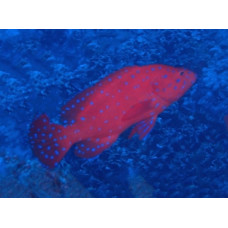Latin name
Cephalopholis oligosticta
Other name
Cephalopholis oligosticta
Identification
Cephalopholis: Greek, kephale = head + Greek, pholis = scale.
The vermilion hind is characterised by the following features: body depth 2.6-3.0 inches horizontally; head length 2.4-2.6 inches vertically; interorbital region slightly convex with a width equal to the diameter of the orbit in a fish 19 cm vertically; anterior orbital depression rounded, posteriorly finely serrated, lower margin more coarsely serrated; suborbital depression and interorbital depression fully serrated; upper jaw extending well beyond the eye.
Features of fish fins
Dorsal spines (total): 9; Dorsal soft rays (total): 14 - 15; Anal spines: 3; Anal soft rays: 9.
Fish colouring
Vermilion hind have a bright red body colour.
Distribution
Widespread in the western Indian Ocean: known only in the Red Sea, from Eilat in the northern Gulf of Aqaba to the Farasan Islands off the southern tip of Saudi Arabia.
Habitat
A tropical marine species that lives on reefs. Depths from 15 to 50 metres.
Size
Максимальная длина самцов этого вида 30,0 см.
Behavior
Does not migrate. Occupies dead reefs in muddy areas as well as muddy lagoons; adults are often found in or near burrows, while juveniles are more likely to be found in areas of coral aggregation.
Food and feeding habits
The Vermilion Hawk feeds on fish and crustaceans.
Reproduction
No information is available on the breeding biology of this species. Mature females of 17 to 19 cm and a mature male of 22 cm have been reported.
Fishing
This species is not commercially important.
Relationship with a person
Harmless.
| Classification | |
| Phylum | Chordata |
| Class | Actinopterygii |
| Squad | Perciformes |
| Family | Epinephelidae |
| Genus | Cephalopholis |
| Species | C. oligosticta |
| Features | |
| Conservation status | Least Concern |
| Habitat | Pelagic |
| Life span, years | No information |
| Maximum body weight, kg | No information |
| Maximum length, cm | 30 |
| Sailing speed, m/s | No information |
| Threat to people | Edible |
| Way of eating | Predator |
Vermilion hind
Tags: vermilion hind

